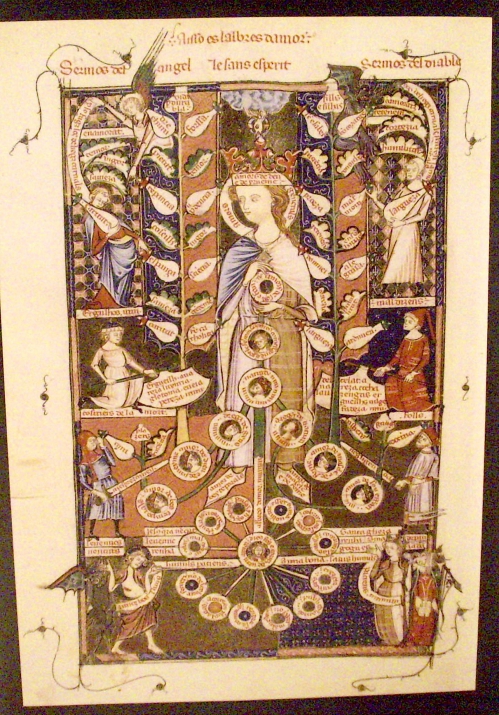Flamenca and the Art of Love
You remember this drawing I bought at Alet-les-Bains? (See here.) I later remembered a book I bought at a Vide Grenier for 10€ about "classic" Occitan literature but had put on one side for the day when I had plenty of time to study it. (Those days do not come often.) So I thought it was a good idea at least to list what info was in it. And so I discovered much more about Flamenca!
"Flamenca," written in the 13th century, was a novel telling us about the amorous adventures of Guilhem de Nevers, "a young knight devoted to all the physical and moral virtues" and the beautiful lady Flamenca, the daughter of the Count, Gui de Nemours, and the wife Archambaut de Bourbon. In this work about the psychology of love, "the aspect the most curious, and the most scandalous, was the ruse of the lovers to find each other in spite of jealousy. Guilhem, instructed by telepathy about the thoughts and wishes of his lady, became a priest. Thus he could go to her, for she had been shut up in a tower by her husband. She had been forbidden to go to mass on Sundays or to take communion. Guilhem also met her in the baths at the foot of the tower. The affair lasted until November; she told her husband she was "guarding the priest as well as he guarded her." Then she rebelled and "became free once again." Once Guilhem had proved himself by winning the tournament, she continued to receive him "in the night."
That is what the Occitan Literature book says.
This was the great erotic novel of the 12th century, about a priest and a high-born lady who fell in love and defied all convention to be together. You can understand then, how thrilled I was, when an exhibition of this great work appeared in my own village in the Narbonnais.
The caption of the first picture says; That which is the subtle and varied talent of the author makes Flamenca an incontestable work of great art. The second picture tells us it was a story of jealousy and the most impious work of the middle ages.
This says, in Occitan and French; She who loves in all fidelity must accept to be criticised by the whole world, foreseeing that she holds one day to sense against her and embracing her, all her pleasure, that which pleases him . . .
Then "A Handbook of love" by Matfre Ermengaud described the detailed minutiae and manners of courtly love, which was like an emotional dance of fashionable ways to love and make love. The picture was a great interest;
You see, they had it all worked out in intricate detail!
Luigi Oliviero explained it like this; I really liked this one. It is really like a Comic, with words in related spaces . On the top I read "Disso es l'albres d'amor" (under here there are the trees of love) on the left "Sermos del Angel" (words of the angel) in the center "Le Sans Esperit" (The Holy Spirit) and on the right "Sermos del Diable" (words of the Devil). Under the crown of the Holy Spirit I read "Amore de deu e de pr"(can't read the last word) (Love of God and of pr....) Could the word have been "Prayer?"
Meanwhile, I read in Jean Markale's book about Montségur; In the Grail legends the Fisher King, Anfortas, cannot be healed of his wound. A curse hangs over him because "in his quest for love he did not respect chastity." Is this some form of plantonic love or the transdendance of Physical love? But courtly love is not platonic or chaste; it is a love quest with definite rules, the main one being that a knight or lady should never love beneath his or her rank on pain of degenerating.
Anfortas dared love a woman not accepted by the Grail or the Grail guardians. He had failed his trust and will remain wounded until he confesses. There is a clear-cut tendency here towards élistism, an elect race, chosen by God. The Grail cup contains blood; the ancient Hebrews believed blood was the vehicle of the soul. The purity of the bloodline must be preserved.
I myself am no means convinced by this point of view but you might like to know more about the Holy Grail and the Bloodline; click here for an in-depth article.
Floral Games preserved Occitan poetry
Another panel in the Exhibition told us that in 1893 Henry Martin, the artist from Toulouse, contributed to the decoration of the "capitol" of Toulouse, with a work on the Troubadours and the creation of the "Gai Saber" - untranslatable, you could call it "sweet wisdom." In 1324, in memory of the Cathars and their music, a group of seven troubadours founded an Academy of Floral Games. Their patron was Clemence Isaure and they held Courts of Love in the style of Eleanor of Aquitaine. People wrote poetry and songs, in Occitan, which were judged at the great annual gathering every 1st May. The poets received only flowers as prices - oh, but what prestige they had! This has continued unbroken from 1324 to the present day. The best known Occitan poet of all, Frédéric Mistral, was a member.
Here is one of Henry Martin's paintings, that we saw in our exhibition (provided by CIRDÒC).
I was quite enraptured . . .
Inscrivez-vous au blog
Soyez prévenu par email des prochaines mises à jour
Rejoignez les 28 autres membres










